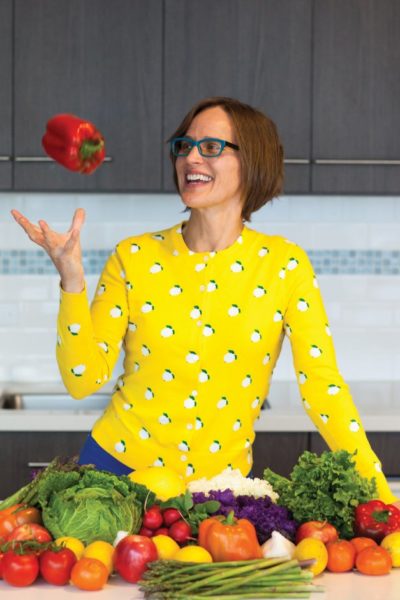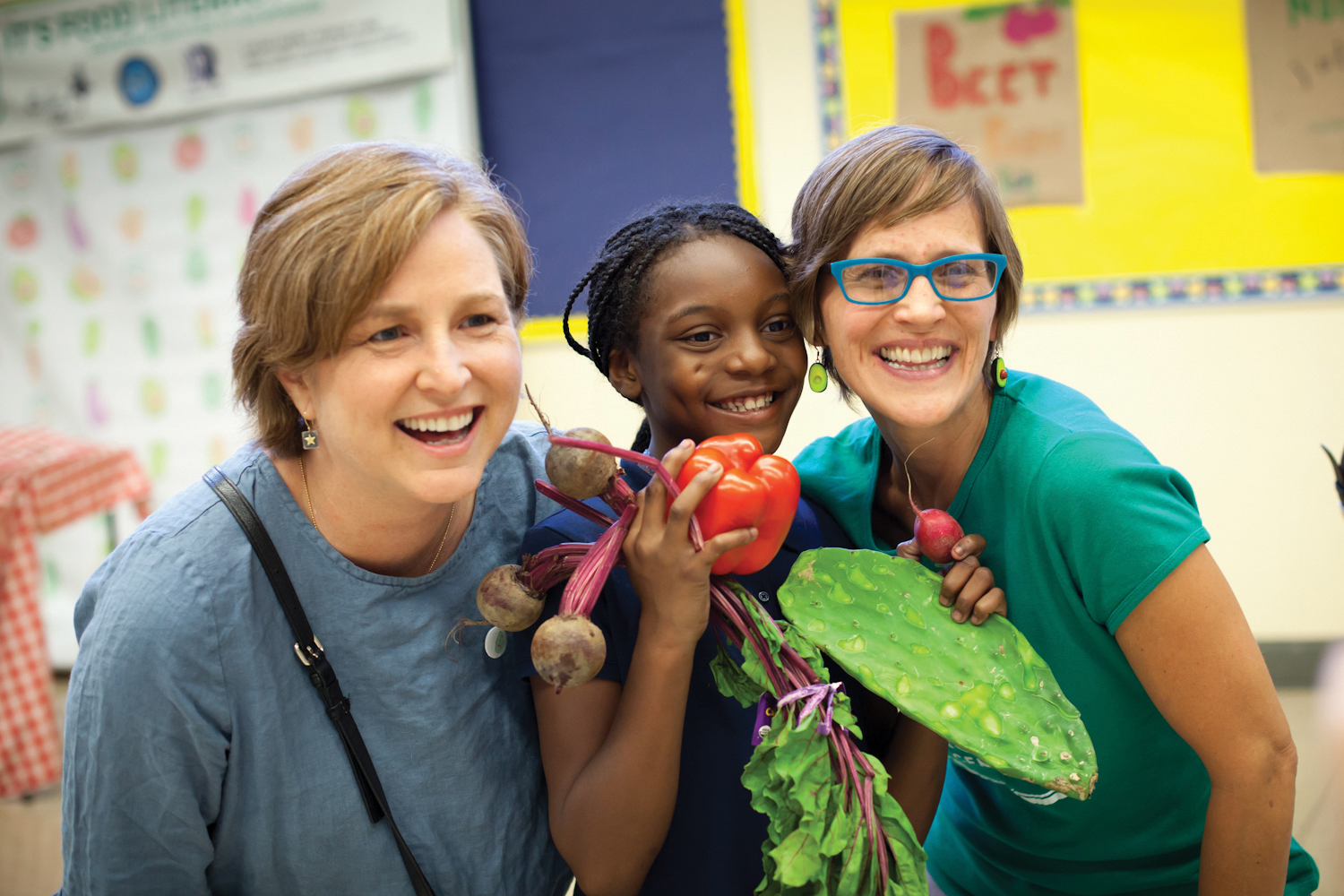
Despite its status as America’s Farm-to-Fork Capital, Sacramento has not escaped the growing childhood obesity crisis. In fact, a recent study of the city’s fifth, seventh and ninth graders found that more than 40 percent are either overweight or obese. Amber Stott is on a mission to change that stat. As CEO of the local nonprofit Food Literacy Center, she is spearheading a new 2.5-acre headquarters, farm and cooking school at Leataata Floyd Elementary in Upper Land Park. The org’s “chief food genius” talks about bringing the bounty of the region to underprivileged youth, tackling picky eaters, and why cooking and nutrition should be on the curriculum along with reading, writing and ’rithmetic.
by Stu VanAirsdale
Portrait by Amy Nicole

YYou founded the Food Literacy Center here in 2011. What is food literacy and how do you teach it?
We define food literacy as understanding the impact of your food choices on your health, the environment and the economy. Our mission is very simple: We inspire kids to eat their vegetables, and we do that by going into low-income schools to teach cooking and nutrition classes during after-school programs. Right now we are exclusively in Sacramento City Unified schools. That’s largely to do with the fact that we’ve built such a great relationship with the district. It makes it a lot easier for us to reach our kids and be successful doing so.
What prompted you to start that work in the first place?
I saw that our food system is broken. I started asking around and interviewing other nonprofits that were doing good work in the food space and trying to determine what the gaps were and where I could actually make a difference. From those interviews, I realized that there were some [discussions] beginning around the problem of chronic disease due to diet. We had rising rates of childhood obesity and type 2 diabetes—this disease that used to affect adults [almost] exclusively was now affecting [many] children. I was hearing from places like the Sacramento Food Bank that they were starting to put more fruits and vegetables in their offerings and remove more junk food from their shelves, but people didn’t necessarily respond immediately because they didn’t know what to do with a lot of fresh fruits and vegetables. We have two generations of Americans that don’t know how to select and prepare fruits and vegetables.
I thought if we started with children and started very early, we could hopefully have a long-term impact in changing their habits and helping them get healthy before these chronic diseases affect them. If kids are eating more fruits and vegetables and they’re more active, then their health is going to improve, or they won’t become sick in the first place. So we have the solution. We’re in America’s Farm-to-Fork Capital. We’re growing all of these amazing fruits and vegetables, yet we’re not getting them to our kids. That’s really what I have set out to do—to get this local stuff to the kids who need it most.
You said that your mission is to inspire kids to eat their vegetables. It seems like the word “inspire” is as important as the word “vegetables.” Education is one thing. But how do you stimulate inspiration?
That word is very intentional. One of our primary [strategies] is that we show up with joy. Often when you talk about eating more fruits and vegetables, people think that you’re going to take things away from them. And we don’t want to start there. So we actually start with a peanut butter sandwich. We know most kids like them. We swap out the jelly for fresh fruit slices, and we tell the kids that we want them eating a fruit or vegetable with every snack or meal. It’s easy to give a kid junk food. It takes a lot of joy and bravery to show up with vegetables. But kids notice when you do, because what they notice is that you care about them and their health.
One of my favorite students was this little boy Gage. He had already had one year of food literacy, and we were back teaching the next school year. And there was a little girl—it was her first time in food literacy. She was sitting next to him. We were making a salad. Every vegetable and fruit we pulled out, she was saying “Eww” and “Gross” and “I don’t like vegetables.” And I finally said something to her like, “Well, gosh, that’s really too bad because Gage, he loves his vegetables.” And, as if on cue, Gage reached across the table to a bowl of baby spinach. He grabbed a fistful and shoved it in his mouth, grinning ear to ear. I saw the little girl looking at him, then looking at her plate. She took a piece of kale and put it in her mouth, and then she took another piece, and all of a sudden her entire plate was clear. It helps when another student lives to tell the tale. I see that a lot, where one kid will be brave enough to try it and then they all get brave. It’s really fun to watch.
Another of our students, her name is Pear—pretty apropos for a Food Literacy [Center] kid. Her mom just happened to be an after-school teacher in one of our schools, so her mom was also taking in everything that we were saying. Pear was one of my students when she was in first grade. Now she’s in middle school, and she’s still cooking. Her mom continually talks to us about the fact that so many of her peers who did not have access to food literacy don’t have great diets and have gotten some of these chronic diseases, and that she’s so grateful that Pear eats healthy, that those habits have stuck with her and she is thriving. It was really important that we reached Pear when she was young.
In addition to your other roles at the center, you have the unique title of chief food genius. I imagine it’s a little tongue in cheek, but what is a food genius?
We run an annual Food Literacy Academy where we train community members to be food geniuses. It’s a certification that we offer. All of the instructors who lead our classes are our food geniuses. So that’s where the title came from. But basically I’m the executive director and the CEO of the nonprofit. I wear [different] hats, from writing recipes to writing grants. My other job is I clean the toilet. We’re a small nonprofit and everybody wears a lot of hats, and I have an amazing team of food geniuses that I get to work with.
You recently broke ground on Floyd Farms—Food Literacy Center’s future HQ, gardens and cooking school at Leataata Floyd Elementary—which is expected to open in late 2020. How will that change things for the organization?
Right now we’re kind of like pop-up caterers, only that it’s the kids who are doing the cooking and they’re doing that cooking in the school cafeteria. [With Floyd Farms] we’re going to actually have a cooking classroom with ovens so we can make more hot food, and they’ll be able to advance their level of cooking skills. We’ll have a commercial kitchen space with more cold storage and more dry storage. And we’ll also have our training and office space so that we can continue to train more food geniuses out in the world and hopefully reach more children.

Help us picture a day on the farm. How might it be integrated into the school curriculum and the neighborhood?
It’s a 2.5-acre site, and it’s a very collaborative, ambitious, unique project. We are partnering with the city of Sacramento, the Sacramento City Unified School District and The Mill at Broadway [housing development]. Say you live in North Land Park and you come to visit our site. The first thing you will hit is a half-acre of community garden space. It’s going to be the biggest community garden in Sacramento. There will be plots that you can get scholarships for if you can’t afford the rental fee on them. Maybe you’re a parent and you’re dropping your kid off at Leataata. You might pop over to your garden plots and harvest some amazing Sun Gold tomatoes, and take those home to prepare lunch or dinner.
Or your child may have a math class where the teacher brings the [students] into our cooking classroom and they learn about measuring as they make a recipe. They learn about fractions and they cook a healthy meal using vegetables that we harvested out of our gardens behind our cooking school—we’ll have about an acre of school gardens separate from the community garden plots. And their brother or sister may be in a class where the science teacher is bringing them into the school garden, where they might learn about composting or parts of a plant as they plant seeds for things that they’ll later cook in their cooking class. Then maybe school gets out, and there’s Family Dinner Night [at Floyd Farms], where family members can show up and eat dinner together from a meal that the students have prepared, showing all the great things they learned. And then they go home with recipes that they can replicate back at home.
It’s a dream. It took a lot of years to work out all the details and get it just right, with everybody’s visions colliding into this perfect world. We will also be serving kids throughout the district. We are going to have events and classes that will be open to the public. So it’s going to be quite expansive in terms of trying to improve health in our community.
Hearing you talk about all this got me thinking of the word “revolutionary.” And then I remembered that the celebrity chef Jamie Oliver sort of gave you that title already—one of his Food Revolution Heroes, right?
Yup. Actually he came out and visited our program twice. We feel very fortunate that he came to Sacramento—he and [Chez Panisse chef-owner] Alice Waters and [school food activist] Ann Cooper, all these pioneers in this field. They were pushing to get this type of food literacy education into the school day. They see it as important as reading and math. They understand that food literacy improves students’ academics.
And when the kids are out of school, what is a healthy change that their parents can make?
The most exciting thing they can do is try a new fruit or vegetable every week—go to the market with their kids and let them pick something out. Become food adventurers together. Either eat it raw, or learn a way to cook it and do that every single week [with a different] fruit or vegetable until you fall in love with 20 or 30 new ones and begin to incorporate them into your life. When you take them one at a time, it’s a little less intimidating, it’s a little more joyful, and it can be a fun game that you play together. And little by little, you’ll be repeating a healthy habit that will stick with you for hopefully the rest of your life. S
For more information on the Food Literacy Center and to find out how to donate or volunteer, visit foodliteracycenter.org
